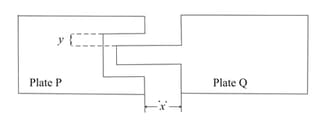EASY
Earn 100
The amount of thermal expansion in solids does not depend on their sizes.
(a)True
(b)False
50% studentsanswered this correctly
Important Questions on Thermal Properties of Matter
MEDIUM
EASY
HARD
(Coefficient of linear expansion and Young’s modulus of brass are and respectively; )
EASY
MEDIUM
(For steel, Young's modulus is and coefficient of thermal expansion is )
MEDIUM
When the temperature of a metal wire is increased from , its length increases by .The percentage change in its mass density will be closed to:
MEDIUM
EASY
MEDIUM
HARD
EASY
HARD
EASY
HARD
MEDIUM
EASY
Two metal plates and of same material are arranged as shown in the figure. If both the plates are uniformly heated through same range of temperature, then

EASY
MEDIUM
EASY
EASY

